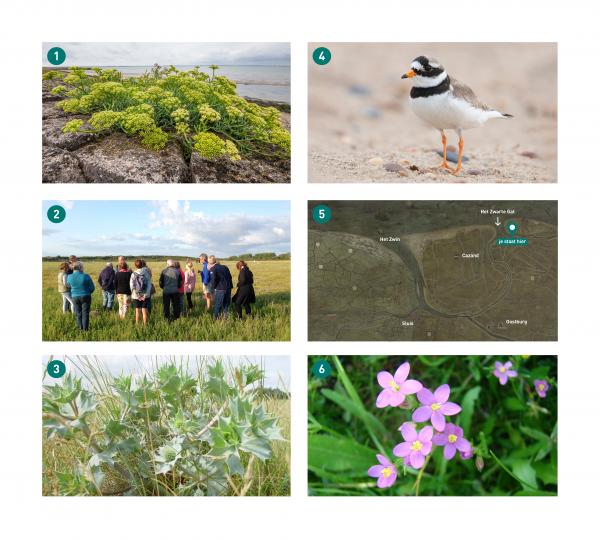Salty and varied
You are standing in front of a unique area; the sea flows in here with every high tide, bringing it to life! The saltwater penetrates deep into the area through the gullies. Various kinds of birds come to forage, rest and breed on the salt marshes, mud flats, beach plains and dunes in spring, and the variation in the soil allows over 200 different plant species to grow here.
From peat landscape to polder
Some 2,600 years ago, this was a vast peat landscape behind beach ridges. The rising sea levels gradually changed the landscape into a salt marsh, creating islets. In the 14th century, a deep sea channel formed, surrounding the then island of Cadzand: the Zwarte Gat (the Black Hole). The Zwarte Polder was created in 1623 to reduce the sea channel.
Back into the deep
During the 1802 storm surge, the Zwarte Polder dyke broke, and the polder disappeared back into the sea. The western part was rebuilt: the Herdijkte Zwarte Polder (Rebuilt Zwarte Polder). The dyke remnants overflowed and became dunes, and the sea turned the area into a dynamic area of salt marshes and mud flats. One of the few small sea channels on an otherwise almost closed coast of the Netherlands and Belgium.
Beach nature
The soil is varied here, from sandy to clay, from salty seawater to fresh rainwater, allowing over 200 wild plant species to grow here. Shorebirds such as the ringed plover and the Eurasian oystercatcher breed on the bird breeding beach on the west side in spring. Birds such as nightingales and warblers nest in the thickets on the dunes.

- Plants such as sea holly, crithmum and sea beet grow in the dune ridge
- Tip: Go on a guided tour!
- Sea holly, -not a thistle despite its looks—is well adapted to the dryness of the dunes
- Shorebirds breed on the beach on bare ground.
- Pieter Pourbus painted this map of the Brugse Vrije in 1571 (artinflanders.be). In 1571, Cadzand was an island with the sea channels Zwin and Zwarte Gat on either side. The Zwarte Polder was constructed to contain this sea channel.
- Sheep keep the grass in check so plants like Centaurium can grow here.
Geopark
The Flemish-Dutch Scheldt Delta is a unique area. The geological genesis, the rich cultural history, and the ongoing struggle between man and water and living with water are tangible everywhere. At the same time, this also makes it one of the most vulnerable areas to climate change. This gives the area all the ingredients for the UNESCO Global Geopark hallmark. More information: www.scheldedelta.eu.
Access
Dogs must be kept on a leash. Keep to the marked trails. Equestrians are only allowed on the marked bridleway. Organised activities require prior written permission from Het Zeeuwse Landschap.




